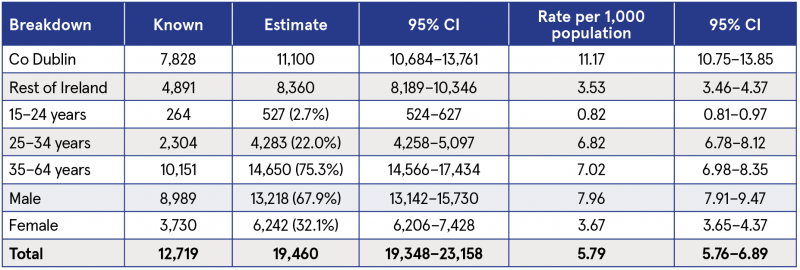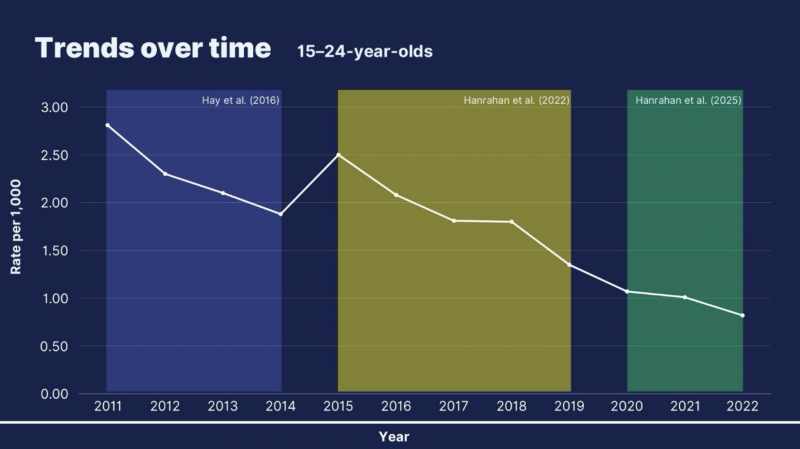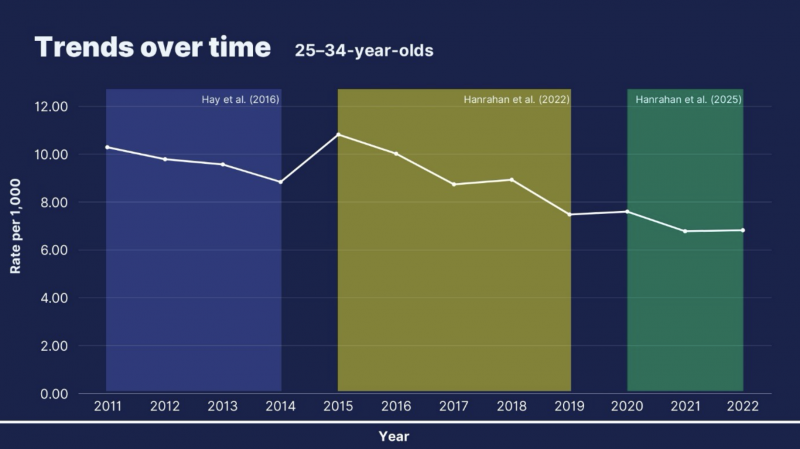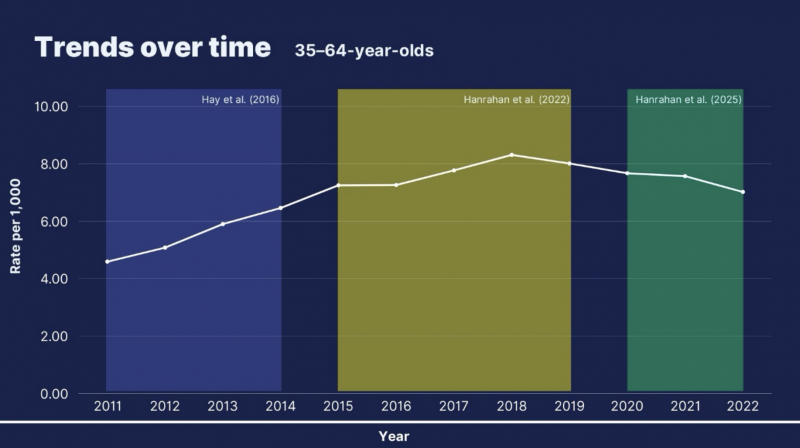Millar, Seán  ORCID: https://orcid.org/0000-0003-4453-8446
(2025)
New estimates of problematic opioid use in Ireland, 2020–2022.
Drugnet Ireland,
Issue 92, Autumn 2025, Supplement,
pp. 2-7.
ORCID: https://orcid.org/0000-0003-4453-8446
(2025)
New estimates of problematic opioid use in Ireland, 2020–2022.
Drugnet Ireland,
Issue 92, Autumn 2025, Supplement,
pp. 2-7.
| Preview | Title | Contact |
|---|---|---|
|
PDF (Drugnet 92 supplement)
970kB |
Background
Problematic opioid use is a significant problem in Ireland and across the world. However, measuring the prevalence of opioid use is challenging. Given the nature of this population, a simple head count is not feasible and general population surveys are known to be ineffective at capturing this ‘hidden’ population. Because people who use drugs fear stigmatisation and are often marginalised in society, the European Union Drugs Agency (EUDA) recommends the use of indirect approaches, such as the capture-recapture (CRC) method, to estimate the prevalence of problematic (high-risk) drug users.1
To date, one regional and four national CRC studies have been conducted in Ireland to estimate the prevalence of problematic opioid use. These studies provided estimates for the years 1996, 2000–01, 2006, 2011–2014, and 2015–2019.2,3,4,5,6 The 1996 regional study examined opioid use in Dublin only and used three data sources: the Health Service Executive (HSE) Central Treatment List (CTL), Hospital In-Patient Enquiry (HIPE) scheme data from four Dublin hospitals, and the An Garda Síochána arrest database. The 2000–01 and 2006 studies were three-source CRC studies that used national data from the CTL, the HIPE scheme and the An Garda Síochána PULSE (Police Using Leading Systems Effectively) database. The 2011–2014 and 2015–2019 studies both used four national data sources: the CTL data were divided into three sources (treatment clinics, general practitioners (GPs), and prison data), and the Probation Service was the fourth data source. In 2020, the Health Research Board (HRB) awarded a contract to the School of Public Health at University College Cork to conduct a fifth study on the prevalence of opioid use in the Republic of Ireland for the years 2020–2022. The methodology and main findings from this study are discussed below.7
Methods
Data on opioid use for the years 2020–2022 were collected from four sources: treatment clinics, general practitioners (GPs), the Irish Prison Service, and the Probation Service. Employing the CRC method, Poisson log-linear models were applied to the overlap data to find the model with the best fit to estimate the hidden population not identified by any of the data sources. Source-by-source interaction terms were tested by adding them to the base model in all possible combinations. The best model for estimating the size of the hidden population was determined by comparing the deviance to the chi-squared distribution and the Akaike information criterion (AIC) value. The simplest model with the lowest AIC value that provided a credible estimate was used.
Results
Table 1 presents a summary of the study’s main results, stratified by Co Dublin versus the rest of Ireland, as well as by age group and sex. In 2022, it was estimated that there were approximately 19,460 individuals in Ireland with problematic opioid use (95% confidence interval (CI): 19,348–23,158), which equates to a prevalence rate of 5.79 per 1,000 population (95% CI: 5.76–6.89). A significant majority of these individuals were male (67.9%), and more than two-thirds (75.3%) fell within the older age group of 35–64-year-olds. There were an estimated 11,100 problematic opioid users (95% CI: 10,684–13,761) in Co Dublin in 2022, reflecting a rate more than three times higher than that in the rest of Ireland (11.17 per 1,000 population (95% CI: 10.75–13.85), compared with 3.53 per 1,000 population (95% CI: 3.46–4.37).
Table 1: Summary of prevalence estimates of problematic opioid use (2022)

Source: Hanrahan et al. (2025)
Trends in problematic opioid use in Ireland over time
Data for the prevalence of problematic opioid use for the years 2020, 2021, 2022 are additionally presented to provide information on changes in trends over time (see Table 2). The overall estimated number of problematic opioid users remained stable between 2020 and 2022, as indicated by overlapping 95% CIs. However, the number of problematic opioid users aged 15–24 years decreased, from 685 (95% CI: 673–779) in 2020 to 527 (95% CI: 524–627) in 2022, which was a statistically significant decrease. No notable changes in the other age groups were observed.
Table 2: Comparison of estimated number of problematic opioid users over time (2020–2022), by age group

Source: Hanrahan et al. (2025)
This study represents the third national CRC study in Ireland to utilise four data sources: clinics, GPs, prisons, and the Probation Service. When comparing summary findings from previous studies with those shown in this report (Table 3), a stable overall estimated number of problematic opioid users was observed in Ireland between 2014 and 2022. There has been a slight decrease in the estimated number of problematic opioid users in Co Dublin; the estimated number of problematic opioid users living in the rest of Ireland outside of Co Dublin has increased from 5,530 (95% CI: 5,406–8,023) in 2014 to 8,360 (95% CI: 8,189–10,346) in 2022. However, these differences were not statistically significant based on overlapping 95% CIs. These data also show that there was no significant change in the proportion of male or female problematic opioid users during this period. Notably, there has been a significant decrease in the estimated number of problematic opioid users aged 15–24 years and aged 25–34 years (Figures 1 and 2), accompanied by a significant increase in the estimated number of problematic opioid users aged 35–64 years between 2011 and 2022 (Figure 3).
Table 3: Comparison of the estimated number of problematic opioid users in Ireland, 2014, 2019, and 2022

Source: Hanrahan et al. (2025)

Figure 1: Comparison of estimated rate of problematic opioid users per 1,000 population over time
(2011–2022), 15–24-year-olds
Source: Hanrahan et al. (2025)

Figure 2: Comparison of estimated rate of problematic opioid users per 1,000 population over time
(2011–2022), 25–34-year-olds
Source: Hanrahan et al. (2025)

Figure 3: Comparison of estimated rate of problematic opioid users per 1,000 population over time
(2011–2022), 35–64-year-olds
Source: Hanrahan et al. (2025)
Discussion
Comparing estimates of problematic opioid use in Ireland with those from other European Union (EU) member states is challenging, due to differences in methodologies and study years. However, the EUDA reports that national rates of high-risk opioid use in the EU range from fewer than 1 to nearly 10 users per 1,000 population aged 15–64 years.8 Based on the European Drug Report 2022: Trends and Developments and data from this study, Ireland would rank sixth highest in the EU for problematic opioid use according to upper 95% CI estimates.8 EU countries with higher estimates include Denmark (4.0–9.6 per 1,000 population), Finland (6.9–8.6 per 1,000 population), Italy (7.2–7.9 per 1,000 population), Latvia (4.6–7.0 per 1,000 population), and Portugal (3.0–7.0 per 1,000 population).8 The United Kingdom (UK) also has high estimates, with rates of 8.1–8.6 per 1,000 population reported in 2018.9 Notably, findings align with trends in other EU countries, where the majority of opioid users are male, and an ageing cohort effect is observed.8 This may reflect improved harm reduction services that enable problematic opioid users to live longer. Additionally, changes in drug use behaviours are evident, with problematic opioid users initiating opioid use later in life, reducing injection practices, using opioids less frequently, and seeking treatment at later stages.10
In conclusion, the results from this study indicate that the overall number of problematic opioid users in Ireland remained stable from 2020 to 2022, but with a significant decrease observed in the 15–24-year-old age group. This decrease is a positive development, given the harmful and addictive nature of opioids. Nevertheless, opioid use prevalence estimates in Ireland remain high. Ongoing research in this area will be crucial for effective service planning and also to enable policy-makers to evaluate the impact of strategies aimed at reducing drug-related harms. Further targeted interventions may be needed in order to enhance the response to opioid misuse in Ireland, thus leading to better outcomes for affected individuals and communities.
An electronic copy of the report is available from the National Drugs Library at: www.drugsandalcohol.ie/42700
1 European Monitoring Centre for Drugs and Drug Addiction (2013) PDU (problem drug use) revision summary. Luxembourg: Publications Office of the European Union, 2013. Available from:
https://www.drugsandalcohol.ie/27693
2 Comiskey C (1998) Estimating the prevalence of opiate drug use in Dublin, Ireland during 1996. Dublin: Department of Health and Children, 1998. Available from: https://www.drugsandalcohol.ie/5080/
3 Kelly A, Carvalho M and Teljeur C (2003) Prevalence of opiate use in Ireland 2000–2001: a 3-source capture recapture study. Dublin: Stationery Office. Available from: https://www.drugsandalcohol.ie/12695/
4 Kelly A, Teljeur C and Carvalho M (2009) Prevalence of opiate use in Ireland 2006: a 3-source capture recapture study. Dublin: Stationery Office. Available from: https://www.drugsandalcohol.ie/12695/
5 Hay G, Jaddoa A, Oyston J, Webster J, Van Hout MC and Rael dos Santos A (2017) Estimating the prevalence of problematic opiate use in Ireland using indirect statistical methods. Dublin: National Advisory Committee on Drugs and Alcohol. Available from: https://www.drugsandalcohol.ie/27233/
6 Hanrahan MT, Millar SR, Phillips KP, Reed TE, Mongan D and Perry IJ (2022) Problematic opioid use in Ireland, 2015–2019. Dublin: Health Research Board. Available from: https://www.drugsandalcohol.ie/35856/
7 Hanrahan MT, Millar SR, Mongan D, Lyons S and Galvin B Prevalence of problematic opioid use in Ireland, 2020–2022. Dublin: Health Research Board, 2025. Available from: www.drugsandalcohol.ie/42700
8 European Monitoring Centre for Drugs and Drug Addiction. European Drug Report 2022: Trends and Developments. Luxembourg: Publications Office of the European Union, 2022. Available from:
https://www.euda.europa.eu/publications/edr/trends-developments/2022_en
9 Public Health England, Home Office, Welsh Government, The Scottish Government, Public Health Wales, Northern Ireland. Department of Health. United Kingdom drug situation: Focal Point annual report 2019. London: Gov.UK, 2020. Available from: https://www.drugsandalcohol.ie/32563/
10 Carew AM and Comiskey C Rising incidence of ageing opioid users within the EU wide treatment demand indicator; The Irish opioid epidemic from 1996 to 2014. Drug Alcohol Depend 2018;192:329-37. Available from: https://www.drugsandalcohol.ie/29783/
A Substance use and dependence > Prevalence > Substance use behaviour
B Substances > Opioids (opiates)
G Health and disease > Substance use disorder (addiction) > Drug use disorder
J Health care, prevention, harm reduction and treatment > Identification and screening > Identification and screening for substance use
VA Geographic area > Europe > Ireland
Repository Staff Only: item control page